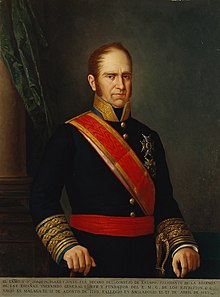Joaquín Blake
This article includes a list of general references, but it lacks sufficient corresponding inline citations. (March 2023) |
Joaquín Blake y Joyes | |
|---|---|
 | |
| Born | 19 August 1759 Vélez-Málaga, Spain |
| Died | 27 April 1827 (aged 67) Valladolid, Spain |
| Allegiance | |
| Commands held | Army of Galicia |
| Battles/wars | |
Joaquín Blake y Joyes (19 August 1759 – 27 April 1827) was a Spanish
Early military career
Partially of
At the outbreak of
In 1802 he was promoted to brigadier in the same promotion as the Count of Caldagues and two of the Palafox brothers, Luis Palafox, Marquis of Lazán and Francisco Palafox.[1]
Peninsular War
Exploits in the field led to further promotions, and by the start of the Peninsular War in 1808, Blake held the rank of
Blake and
Furious, the
Blake chose to make another stand at
Blake lost 3,001 men on the battlefield, and many thousands more were dispersed in the confusion of retreat as the Spanish front disintegrated. Knowing the Army of Galicia to be irreparably shattered, Blake embarked on a grueling march west into the hills, outdistancing his pursuers under
Battle of Albuera
In 1810, Blake participated in the creation of a Spanish
On 16 May 1811 Blake fought the French at Albuera alongside
Siege of Valencia (1812)
Blake was then transferred to eastern Spain to combat
Blake was sent to the
Later life
In 1815 Blake was made
See also
- The Tribes of Galway
References
- ^ (in Spanish). Gaceta de Barcelona, no. 1750, p. 15. 6 October 1802. Hemeroteca Digital. Biblioteca Nacional de España. Retrieved 1 May 2023.
- ^ Oman, Charles (1914). A History of the Peninsular War, Vol. 5, Oct. 1811-Aug. 31, 1812, p. 73. Oxford University Press. Project Gutenberg. Retrieved 8 March 2023.
Further reading
- Alexander, Don W. (1985). Rod of Iron: French Counterinsurgency Policy in Aragon During the Peninsular War. SR Books. ISBN 0-8420-2218-X.
- Esdaile, Charles J. (1988). The Spanish Army in the Peninsular War. Manchester University Press. ISBN 0-7190-2538-9.
- Fletcher, Ian (2001). Bloody Albuera: The 1811 Campaign in the Peninsular War. Crowood. ISBN 1-86126-372-4.
- Gates, David (1986). The Spanish Ulcer: A History of the Peninsular War. W W Norton. ISBN 0-393-02281-1.
- Oliver, Michael (2007). The Battle of Albuera 1811: Glorious Field of Grief. Pen and Sword. ISBN 1-84415-461-0.
